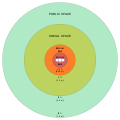Personal space
Personal space is a concept on psychology and sociology. The concept talks about two people (the "actors"). They have space around them. The closer they are to each other emotionally, the closer an actor will be able to stand to the other, without being intrusive. The concept was introduced by Edward T. Hall in 1966.[1]
Discomfort results if one actor steps into the personal space of the other, without this being desired. The amount of space a being needs can be classified in two categories:
- Immediate individual physical space (determined by imagined limits)
- A space an individual considers theirs to live in; this is often called territory or habitat. Its size is dependent on many things, such as growth needs, habits, courtships, etc.
Hall's spacing models were based on Heini Hediger's 1955 psychological studies of zoo animals.[2]
Personal Space Media
A chart depicting Edward T. Hall's interpersonal distances of man, showing radius in feet and meters
References
- ↑ Hall, Edward T. (1966). The hidden dimension. Anchor Books. ISBN 0-385-08476-5.
- ↑ Hediger, Heini (1955). The psychology and behavior of animals in zoos and circuses. Dover Publications. SBN 486622185.


